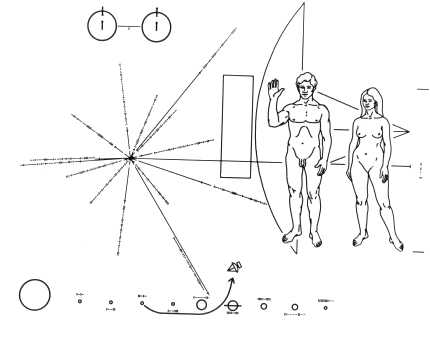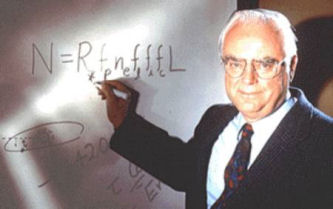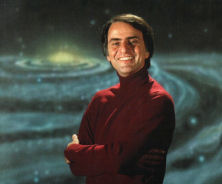Intelligent Life
|
"The Universe is populated by innumerable suns, innumerable earths, and perhaps, innumerable forms of life. That thought expresses the essence of the Copernican revolution. No revelation more striking has ever come from the scientific mind."
~ Robert Jastrow<
Academic discussions about extra-terrestrial intelligent life typically begin with
an introduction to the Drake Equation. It was developed by Frank Drake in 1961
in order to codify the important factors that can be multiplied to determine
how many intelligent, communicating civilizations there are in our galaxy.
The Drake Equation
N = R* fp ne fl fi fc L R* is the rate of star birth in the Milky Way Galaxy fp is the fraction of stars that have planets around them. ne is the number of planets per star that are capable of sustaining life. fl is the fraction of planets in ne where life evolves. fi is the fraction of fl where intelligent life evolves. fc is the fraction of fi who are seeking to communicate. L is length of time during which the communicating civilizations exist and actively attempt contact. The resulting product, N, is the total number of communicating civilizations in the galaxy who are currently trying to contact us. The amazing thing about the Drake Equation is that no matter how conservative you are with the values of the individual factors, it leads to an incredibly large number of beings out there, with radios, attempting to contact one another. Human attempts to connect with a galactic community are only fledgling. The most famous and organized effort is called SETI (Search for Extraterrestrial Life) which was founded by Frank Drake in 1961. Anyone with an Internet connection can now join the effort by lending their computer's idle time to analyzing radio signals from space in the hopes of finding unnatural patterns. The computer sharing program is administrated by SETI@HOME at University of California Berkeley.
Carl Sagan Center for the Study of Life in the Universe
Named for the famous popularizer of astronomy, SETI has created this team of diverse researchers in a interdiciplinary field called "astrobiology." Supporting institutions included NASA, the National Science Foundation, and major universities. Research includes such related areas as Astronomy, Chemical evolution, Origin of life, Biological evolution Cultural Evolution, and active search for extraterrestrial intelligence. Carl Sagan conceived the idea of a attaching a universal message to a spacecraft destined to leave the solar system which might be understood by extraterrestrials that find it. He succeeded in delilvering that message to interstellar space in the form of plaques, attached to the space probes Pioneer 10 launched in 1972 and Pioneer 11 launched in 1973. 
The message was designed to encode the most information possible in minimal space. At the top is a diagram representing the hyperfine transition of neutral hydrogen. This is meant to convey a unit of length (21 cm) which is used to indicate measurements elsewhere in the message. The radial lines emanating from a point show the relative distances to 14 pulsars from our Sun and the distance to the galactic core. This could conceivably be used by a clever species to identify our Sun's location within the Milky Way Galaxy. A tick mark at the end of each line gives the Z coordinate perpendicular to the galactic plane. The pulse rate of the pulsars is included, and since pulsars slow their pulsing at a predictable rate, a successful decoding of the placque would also indicate precisely when the spacecraft was launched. The image also includes a diagram of our solar system, the spacecraft's route out of the solar system, and a silhouette of the craft itself. 
UFO's, Alien Abductions, & Crop Circles
As exciting and as entertaining as the stories are, astronomers as a group place very low confidence in theories that include visitation to Earth by extraterrestrials. There are two main reasons for this skepticism. First of all, with thousands of anecdotes of contact, there should be at least one sample of empirical evidence; something besides hearsay. Second, astronomers appreciate the extent of the problem of the vastness of space and time. It is a given that there is much we don't know, but if beings adventured across the void to find us here, then they likely left home long before we even existed. This would be an astonishing coincidence, especially if their objective was to vandalize our corn. So here is the conundrum. Any beings truely intelligent enough to make the trip would make radio contact first. Radio is cheap, and radio signals travel at the speed of light. |

